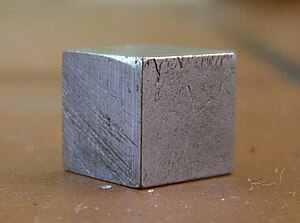 |
|
| Allotropes | alpha, α (gray); beta, β (white) |
|---|
| Appearance | silvery-white (beta, β) or gray (alpha, α) |
|---|
| Standard atomic weight (Ar, standard) | 118.710(7) |
|---|
|
|
| Atomic number (Z) | 50 |
|---|
| Group | group 14 (carbon group) |
|---|
| Period | period 5 |
|---|
| Block | p-block |
|---|
| Element category | post-transition metal |
|---|
| Electron configuration | [Kr] 4d10 5s2 5p2 |
|---|
Electrons per shell | 2, 8, 18, 18, 4 |
|---|
|
| Phase at STP | Sn: Solid |
|---|
| Melting point | 505.08 K (231.93 °C, 449.47 °F) |
|---|
| Boiling point | 2875 K (2602 °C, 4716 °F) |
|---|
| Density (near r.t.) | white, β: 7.265 g/cm3
gray, α: 5.769 g/cm3 |
|---|
| when liquid (at m.p.) | 6.99 g/cm3 |
|---|
| Heat of fusion | white, β: 7.03 kJ/mol |
|---|
| Heat of vaporization | white, β: 296.1 kJ/mol |
|---|
| Molar heat capacity | white, β: 27.112 J/(mol·K) |
|---|
Vapor pressure| P (Pa) | 1 | 10 | 100 | 1 k | 10 k | 100 k |
|---|
| at T (K) | 1497 | 1657 | 1855 | 2107 | 2438 | 2893 |
|---|
|
|
| Oxidation states | −4, −3, −2, −1, +1,+2, +3,+4 (an amphoteric oxide) |
|---|
| Electronegativity | Pauling scale: 1.96 |
|---|
| Ionization energies | - 1st: 708.6 kJ/mol
- 2nd: 1411.8 kJ/mol
- 3rd: 2943.0 kJ/mol
-
|
|---|
| Atomic radius | empirical: 140 pm |
|---|
| Covalent radius | 139±4 pm |
|---|
| Van der Waals radius | 217 pm |
|---|
| Spectral lines of tin |
|
| Natural occurrence | Sn: Primordial |
|---|
| Crystal structure | tetragonal
white (β) |
|---|
| Crystal structure | face-centered diamond-cubic
gray (α) |
|---|
| Speed of sound thin rod | 2730 m/s (at r.t.) (rolled) |
|---|
| Thermal expansion | 22.0 µm/(m·K) (at 25 °C) |
|---|
| Thermal conductivity | 66.8 W/(m·K) |
|---|
| Electrical resistivity | 115 nΩ·m (at 0 °C) |
|---|
| Magnetic ordering | gray: diamagnetic
white (β): paramagnetic |
|---|
| Magnetic susceptibility | (white) +3.1·10−6 cm3/mol (298 K) |
|---|
| Young's modulus | 50 GPa |
|---|
| Shear modulus | 18 GPa |
|---|
| Bulk modulus | 58 GPa |
|---|
| Poisson ratio | 0.36 |
|---|
| Brinell hardness | 50–440 MPa |
|---|
| CAS Number | 7440-31-5 |
|---|
|
| Discovery | around 3500 BC |
|---|
|
|
| | references |






